StochasticCalculusAlan Bain�
1. Introduction
The following notes aim to provide a very informal introduction to Stochastic Calculus,
and especially to the Itˆo integral and some of its applications. They owe a great deal to Dan
Crisan’s Stochastic Calculus and Applications lectures of 1998; and also much to various
books especially those of L. C. G. Rogers and D. Williams, and Dellacherie and Meyer’s
multi volume series ‘Probabilities et Potentiel’. They have also benefited from insights
gained by attending lectures given by T. Kurtz.
The present notes grew out of a set of typed notes which I produced when revising
for the Cambridge, Part III course; combining the printed notes and my own handwritten
notes into a consistent text. I’ve subsequently expanded them inserting some extra proofs
from a great variety of sources. The notes principally concentrate on the parts of the course
which I found hard; thus there is often little or no comment on more standard matters; as
a secondary goal they aim to present the results in a form which can be readily extended
Due to their evolution, they have taken a very informal style; in some ways I hope this
may make them easier to read.
The addition of coverage of discontinuous processes was motivated by my interest in
the subject, and much insight gained from reading the excellent book of J. Jacod and
A. N. Shiryaev.
The goal of the notes in their current form is to present a fairly clear approach to
the Itˆo integral with respect to continuous semimartingales but without any attempt at
maximal detail. The various alternative approaches to this subject which can be found
in books tend to divide into those presenting the integral directed entirely at Brownian
Motion, and those who wish to prove results in complete generality for a semimartingale.
Here at all points clarity has hopefully been the main goal here, rather than completeness;
although secretly the approach aims to be readily extended to the discontinuous theory.
I make no apology for proofs which spell out every minute detail, since on a first look at
the subject the purpose of some of the steps in a proof often seems elusive. I’d especially
like to convince the reader that the Itˆo integral isn’t that much harder in concept than
the Lebesgue Integral with which we are all familiar. The motivating principle is to try
and explain every detail, no matter how trivial it may seem once the subject has been
understood!
Passages enclosed in boxes are intended to be viewed as digressions from the main
text; usually describing an alternative approach, or giving an informal description of what
is going on – feel free to skip these sections if you find them unhelpful.
In revising these notes I have resisted the temptation to alter the original structure
of the development of the Itˆo integral (although I have corrected unintentional mistakes),
since I suspect the more concise proofs which I would favour today would not be helpful
on a first approach to the subject.
These notes contain errors with probability one. I always welcome people telling me
about the errors because then I can fix them! I can be readily contacted by email as
alanb@chiark.greenend.org.uk. Also suggestions for improvements or other additions
are welcome.
Alan Bain
[i]
�
2. Contents
.
.
.
.
.
.
.
.
.
.
.
.
.
.
.
.
.
.
.
.
.
.
.
.
.
.
.
.
.
.
.
.
.
.
.
.
.
.
.
.
.
.
.
.
.
.
.
.
.
.
.
.
.
.
.
.
.
.
.
.
.
.
.
7. The Integral
.
4.1. Stopping Times
.
.
1. Introduction .
2. Contents .
.
.
3. Stochastic Processes .
3.1. Probability Space .
3.2. Stochastic Process
.
.
.
.
.
.
.
.
.
.
5.1. Local Martingales
.
5.2. Local Martingales which are not Martingales
.
.
.
.
.
.
.
.
.
.
.
.
.
.
.
.
.
.
.
.
.
6. Total Variation and the Stieltjes Integral .
.
.
.
.
.
.
.
.
.
.
.
.
.
.
.
.
.
.
.
.
.
.
.
.
.
.
.
10.1. The UCP topology
10.2. Approximation via Riemann Sums
.
.
.
9. Semimartingales .
10. Relations to Sums
8. The Stochastic Integral
11. Itˆo’s Formula .
.
.
.
.
.
.
.
.
.
.
.
.
.
.
.
.
.
.
.
.
.
.
.
.
.
.
.
.
.
.
.
.
.
.
.
.
.
.
.
.
.
.
.
.
.
.
.
.
.
.
.
.
.
.
.
.
.
.
.
.
.
.
.
.
.
.
.
.
.
.
.
.
.
.
.
.
.
.
.
.
.
.
.
.
.
.
.
.
.
.
.
.
.
.
.
.
.
.
.
.
.
.
.
.
.
.
.
.
.
.
.
.
.
.
.
.
.
.
.
.
.
.
.
.
.
.
.
.
.
.
.
.
.
.
.
.
.
.
.
5. Basics
4. Martingales
6.1. Why we need a Stochastic Integral
.
6.2. Previsibility
.
6.3. Lebesgue-Stieltjes Integral
.
.
.
.
.
.
.
.
7.1. Elementary Processes
.
7.2. Strictly Simple and Simple Processes
.
.
8.1. Integral for H ∈ L and M ∈ M2
.
.
.
8.2. Quadratic Variation
8.3. Covariation
.
.
.
8.4. Extension of the Integral to L2(M)
8.5. Localisation
.
8.6. Some Important Results
.
.
.
.
.
.
.
.
.
.
.
.
.
.
.
.
.
.
.
.
.
.
.
.
.
.
.
.
.
.
.
.
.
.
12. L´evy Characterisation of Brownian Motion .
.
13. Time Change of Brownian Motion .
.
.
.
.
.
.
.
.
.
.
.
.
.
.
.
.
.
.
.
.
.
.
.
.
.
.
.
.
.
.
.
.
.
.
.
.
.
.
.
.
.
.
15. Brownian Martingale Representation Theorem .
.
.
16. Stochastic Differential Equations
.
17. Relations to Second Order PDEs .
.
.
.
.
.
11.1. Applications of Itˆo’s Formula
11.2. Exponential Martingales
.
13.1. Gaussian Martingales
14. Girsanov’s Theorem .
17.1. Infinitesimal Generator
.
17.2. The Dirichlet Problem .
14.1. Change of measure
.
.
.
.
.
.
.
.
.
.
.
.
.
.
.
.
.
.
.
.
.
.
.
.
.
.
.
.
.
.
.
.
.
.
.
.
.
.
.
.
.
.
.
.
.
.
.
.
.
.
.
.
.
.
.
.
.
.
.
.
.
.
.
.
.
.
.
.
.
.
.
.
.
.
.
.
.
.
.
.
.
.
.
.
.
.
.
.
.
.
.
.
.
.
.
.
.
.
.
.
.
.
.
.
.
.
.
.
.
.
.
.
.
.
.
.
.
.
.
.
.
.
.
.
.
.
.
.
.
.
.
.
.
.
.
.
.
.
.
.
.
.
.
.
.
.
.
.
.
.
.
.
.
.
.
.
.
.
.
.
.
.
.
.
.
.
.
.
.
.
.
.
.
.
.
.
.
.
.
.
.
.
.
.
.
.
.
.
.
.
.
.
.
.
.
.
.
.
.
.
.
.
.
.
.
.
.
.
.
.
.
.
.
.
.
.
.
.
.
.
.
.
.
.
.
.
.
.
.
.
.
.
.
.
.
.
.
.
.
.
.
.
.
.
.
.
.
.
.
.
.
.
.
.
.
.
.
.
.
.
.
.
.
.
.
.
.
.
.
.
.
.
.
.
.
.
.
.
.
.
.
.
.
.
.
.
.
.
.
.
.
.
.
.
.
.
.
.
.
.
.
.
.
.
.
.
.
.
.
.
.
.
.
.
.
.
.
.
.
.
.
.
.
.
.
.
.
.
.
.
.
.
.
.
.
.
.
.
.
.
.
.
.
.
.
.
.
.
.
.
.
.
.
.
.
.
.
.
.
.
.
.
.
.
.
.
.
.
.
.
.
.
.
.
.
.
.
.
.
.
.
.
.
.
.
.
.
.
.
.
.
.
.
.
.
.
.
.
.
.
.
.
.
.
.
.
.
.
.
.
.
.
.
.
.
.
.
.
.
.
.
.
.
.
.
.
.
.
.
.
.
.
.
.
.
.
.
.
.
.
.
i
ii
1
1
1
4
4
8
8
9
11
11
12
13
15
15
15
17
17
19
22
23
26
27
29
31
31
32
35
40
41
46
48
49
51
51
53
56
61
61
62
[ii]
�
Contents
iii
18. Stochastic Filtering .
.
.
.
.
.
.
.
.
.
.
.
.
.
.
.
.
.
.
.
.
.
.
.
.
.
.
.
.
.
.
.
.
.
.
.
.
.
.
.
.
.
.
.
.
.
.
.
.
.
.
.
.
.
.
.
.
17.3. The Cauchy Problem .
.
17.4. Feynman-Ka˘c Representation .
.
.
.
.
.
.
.
.
.
.
18.1. Signal Process
.
18.2. Observation Process
.
.
18.3. The Filtering Problem .
.
18.4. Change of Measure
.
.
18.5. The Unnormalised Conditional Distribution .
.
18.6. The Zakai Equation
.
18.7. Kushner-Stratonowich Equation .
.
.
.
.
.
.
.
.
.
.
.
.
.
21.1. Compensators .
.
21.2. RCLL processes revisited .
.
.
.
.
.
.
.
.
.
.
.
.
.
.
.
.
.
.
.
.
.
.
.
.
.
.
.
.
.
.
.
.
.
.
.
.
.
.
.
.
.
.
.
.
.
.
.
.
.
.
.
.
.
.
19. Gronwall’s Inequality .
.
20. Kalman Filter .
.
20.1. Conditional Mean .
.
20.2. Conditional Covariance .
.
.
.
.
21. Discontinuous Stochastic Calculus
.
.
.
22. References
.
.
.
.
.
.
.
.
.
.
.
.
.
.
.
.
.
.
.
.
.
.
.
.
.
.
.
.
.
.
.
.
.
.
.
.
.
.
.
.
.
.
.
.
.
.
.
.
.
.
.
.
.
.
.
.
.
.
.
.
.
.
.
.
.
.
.
.
.
.
.
.
.
.
.
.
.
.
.
.
.
.
.
.
.
.
.
.
.
.
.
.
.
.
.
.
.
.
.
.
.
.
.
.
.
.
.
.
.
.
.
.
.
.
.
.
.
.
.
.
.
.
.
.
.
.
.
.
.
.
.
.
.
.
.
.
.
.
.
.
.
.
.
.
.
.
.
.
.
.
.
.
.
.
.
.
.
.
.
.
.
.
.
.
.
.
.
.
.
.
.
.
.
.
.
.
.
.
.
.
.
.
.
.
.
.
.
.
.
.
.
.
.
.
.
.
.
.
.
.
.
.
.
64
66
69
69
70
70
70
76
78
86
87
89
89
90
92
92
94
96
�
3. Stochastic Processes
The following notes are a summary of important definitions and results from the theory of
stochastic processes, proofs may be found in the usual books for example [Durrett, 1996].
3.1. Probability Space
Let (Ω,F, P) be a probability space. The set of P-null subsets of Ω is defined by
N := {N ⊂ Ω : N ⊂ A for A ∈ F, with P(A) = 0} .
The space (Ω,F, P) is said to be complete if for A ⊂ B ⊂ Ω with B ∈ F and P(B) = 0
then this implies that A ∈ F.
In addition to the probability space (Ω,F, P), let (E,E) be a measurable space, called
the state space, which in many of the cases considered here will be (R,B), or (Rn,B). A
random variable is a F/E measurable function X : Ω → E.
3.2. Stochastic Process
Given a probability space (Ω,F, P) and a measurable state space (E,E), a stochastic
process is a family (Xt)t≥0 such that Xt is an E valued random variable for each time
t ≥ 0. More formally, a map X : (R+ × Ω,B+ ⊗ F) → (R,B), where B+ are the Borel sets
of the time space R+.
Definition 1. Measurable Process
The process (Xt)t≥0 is said to be measurable if the mapping (R+ × Ω,B+ ⊗ F) → (R,B) :
(t, ω) → Xt(ω) is measurable on R × Ω with respect to the product σ-field B(R) ⊗ F.
Associated with a process is a filtration, an increasing chain of σ-algebras i.e.
Define F∞ by
Fs ⊂ Ft if 0 ≤ s ≤ t < ∞.
F∞ =
t≥0
Ft := σ
.
Ft
t≥0
If (Xt)t≥0 is a stochastic process, then the natural filtration of (Xt)t≥0 is given by
F X
t
:= σ(Xs : s ≤ t).
The process (Xt)t≥0 is said to be (Ft)t≥0 adapted, if Xt is Ft measurable for each t ≥ 0.
The process (Xt)t≥0 is obviously adapted with respect to the natural filtration.
[1]
�
Stochastic Processes
2
Definition 2. Progressively Measurable Process
A process is progressively measurable if for each t its restriction to the time interval [0, t],
is measurable with respect to B[0,t] ⊗ Ft, where B[0,t] is the Borel σ algebra of subsets of
[0, t].
Why on earth is this useful? Consider a non-continuous stochastic process Xt. From
the definition of a stochastic process for each t that Xt ∈ Ft. Now define Yt = sups∈[0,t] Xs.
Is Ys a stochastic process? The answer is not necessarily – sigma fields are only guaranteed
closed under countable unions, and an event such as
{Ys > 1} =
0≤s≤s
{Xs > 1}
is an uncountable union. If X were progressively measurable then this would be sufficient
to imply that Ys is Fs measurable. If X has suitable continuity properties, we can restrict
the unions which cause problems to be over some dense subset (say the rationals) and this
solves the problem. Hence the next theorem.
Theorem 3.3.
Every adapted right (or left) continuous, adapted process is progressively measurable.
Proof
We consider the process X restricted to the time interval [0, s]. On this interval for each
n ∈ N we define
2n−1
X n
1 :=
1(ks/2n,(k+1)s/2n](t)Xks/2n(ω),
k=0
X n
2 := 1[0,s/2n)(t)X0(ω) +
2n
k=1
1[ks/2n,(k+1)s/2n)(t)X(k+1)s/2n(ω)
1 is a left continuous process, so if X is left continuous, working pointwise
But the individual summands in the definition of X n
1 are by the adpatedness of X
1 is also. But the convergence implies X is also;
Note that X n
(that is, fix ω), the sequence X n
clearly B[0,s] ⊗ Fs measurable, hence X n
hence X is progressively measurable.
Consideration of the sequence X n
1 converges to X.
processes.
2 yields the same result for right continuous, adapted
The following extra information about filtrations should probably be skipped on a
first reading, since they are likely to appear as excess baggage.
�
Define
Stochastic Processes
∀t ∈ (0,∞) Ft− =
∀t ∈ [0,∞) Ft+ =
0≤s
4. Martingales
Let X = {Xt,Ft, t ≥ 0} be an integrable process. Then define Ft+ :=
Definition 4.1.
Let X = {Xt,Ft, t ≥ 0} be an integrable process then X is a
(i) Martingale if and only if E(Xt|Fs) = Xs a.s. for 0 ≤ s ≤ t < ∞
(ii) Supermartingale if and only if E(Xt|Fs) ≤ Xs a.s. for 0 ≤ s ≤ t < ∞
(iii) Submartingale if and only if E(Xt|Fs) ≥ Xs a.s. for 0 ≤ s ≤ t < ∞
Theorem (Kolmogorov) 4.2.
�>0 Ft+� and also
the partial augmentation of F by ˜Ft = σ(Ft+,N ). Then if t → E(Xt) is continuous there
exists an ˜Ft adapted stochastic process ˜X = { ˜Xt, ˜Ft, t ≥ 0} with sample paths which are
right continuous, with left limits (CADLAG) such that X and ˜X are modifications of each
other.
Definition 4.3.
A martingale X = {Xt,Ft, t ≥ 0} is said to be an L2-martingale or a square integrable
martingale if E(X 2
Definition 4.4.
E(|Xt|p) < ∞.
A process X = {Xt,Ft, t ≥ 0} is said to be Lp bounded if and only if supt≥0
The space of L2 bounded martingales is denoted by M2, and the subspace of continuous
L2 bounded martingales is denoted Mc
2.
Definition 4.5.
A process X = {Xt,Ft, t ≥ 0} is said to be uniformly integrable if and only if
t ) < ∞ for every t ≥ 0.
E|Xt|1|Xt|≥N
→ 0 as N → ∞.
sup
t≥0
Orthogonality of Martingale Increments
A frequently used property of a martingale M is the orthogonality of increments property
which states that for a square integrable martingale M, and Y ∈ Fs with E(Y 2) < ∞ then
E [Y (Mt − Ms)] = 0
for t ≥ s.
Proof
Via Cauchy Schwartz inequality E|Y (Mt − Ms)| < ∞, and so
E(Y (Mt − Ms)) = E (E(Y (Mt − Ms)|Fs)) = E (Y E(Mt − Ms|Fs)) = 0.
A typical example is Y = Ms, whence E(Ms(Mt − Ms)) = 0 is obtained. A common
application is to the difference of two squares, let t ≥ s then
E((Mt − Ms)2|Fs) =E(M 2
=E(M 2
t |Fs) − 2MsE(Mt|Fs) + M 2
t − M 2
s |Fs) = E(M 2
t |Fs) − M 2
s .
s
[4]
�
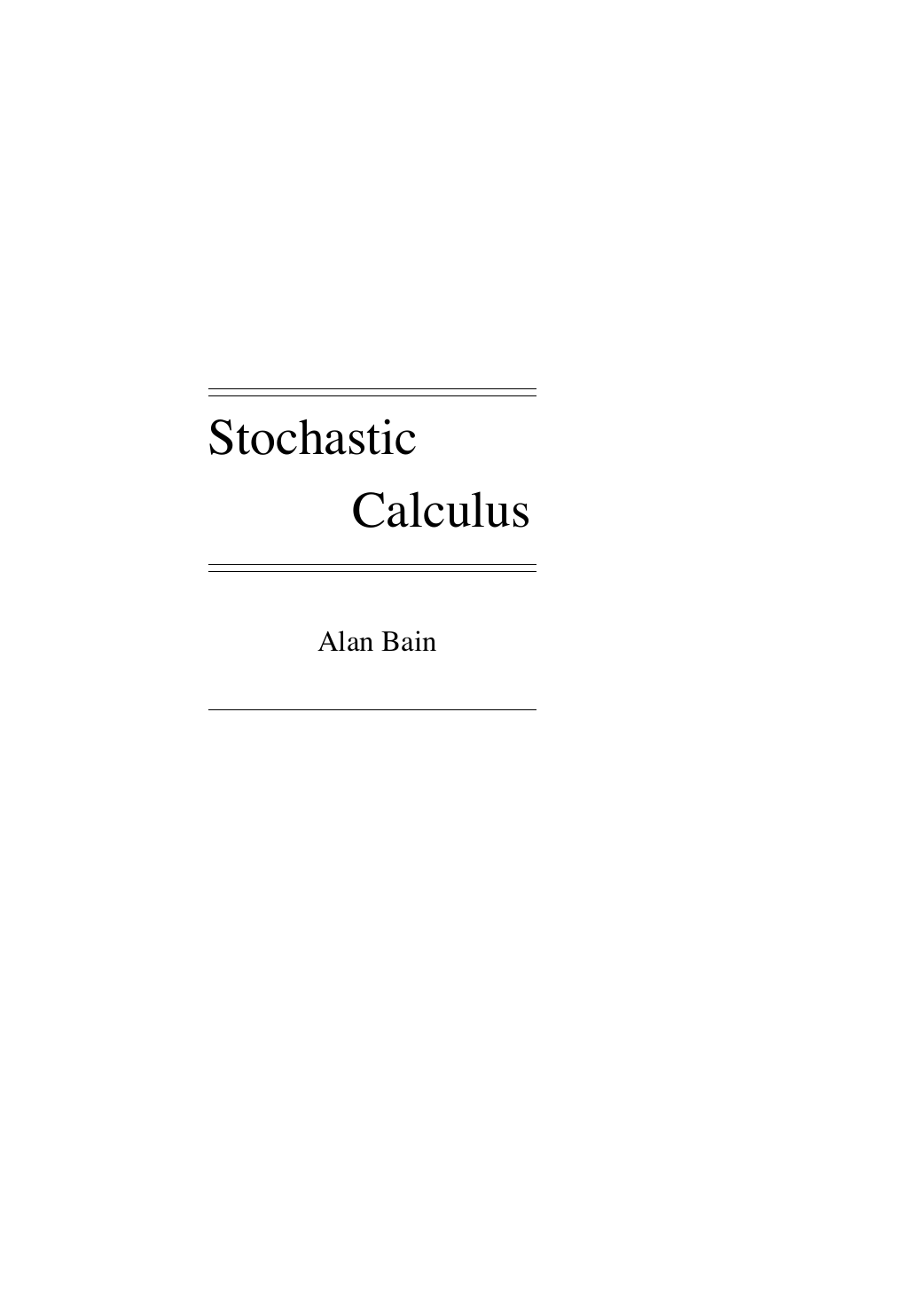
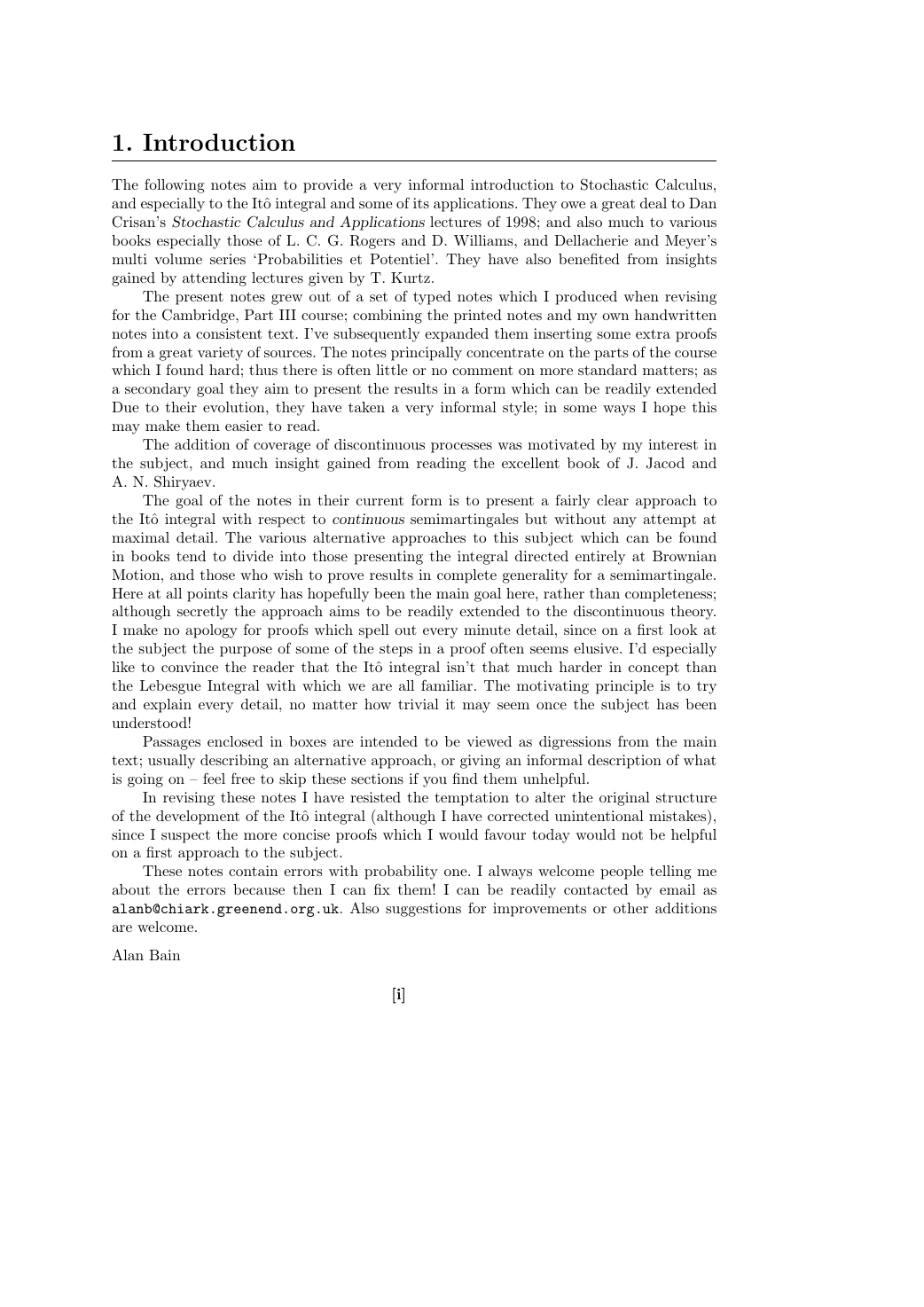
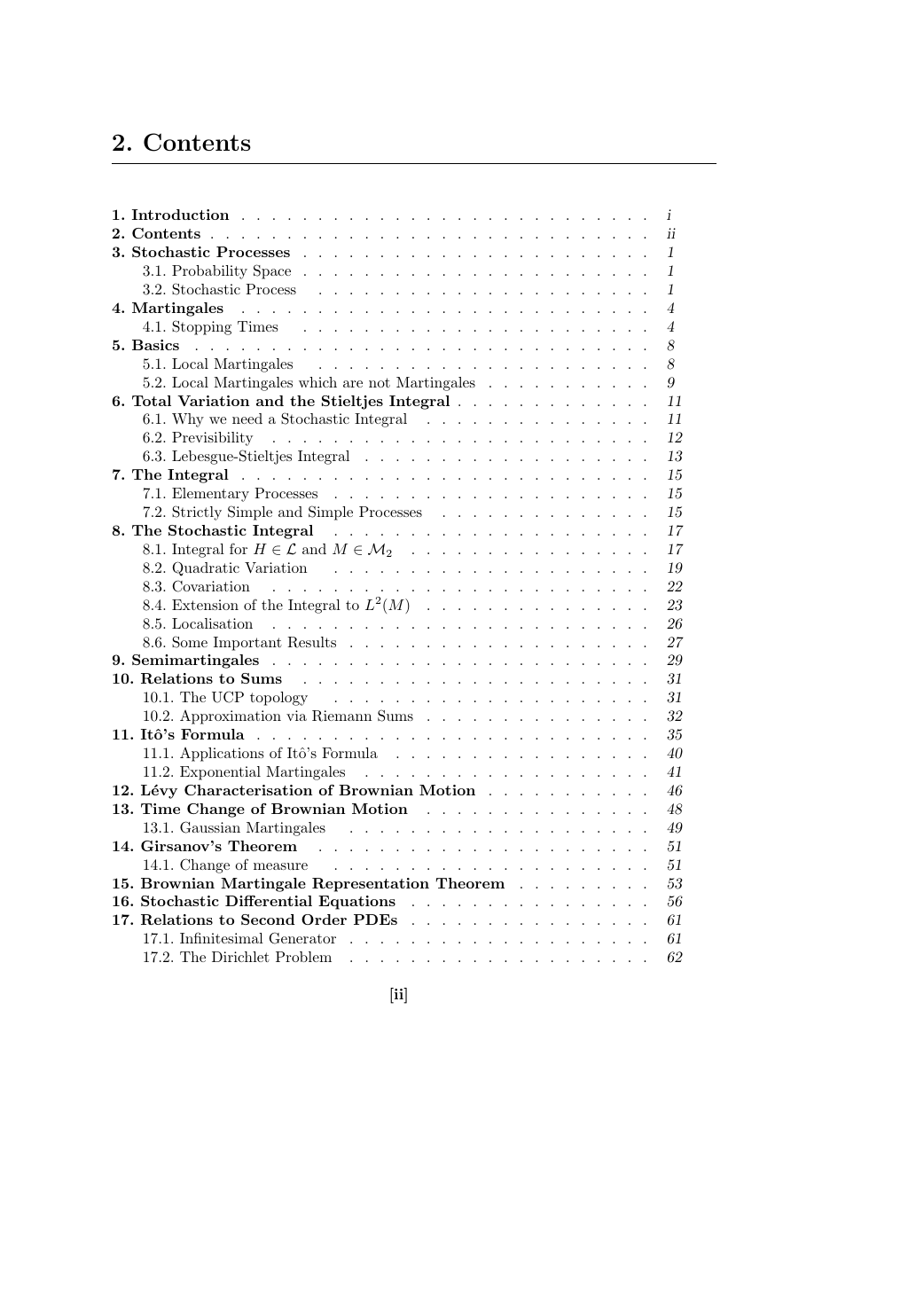
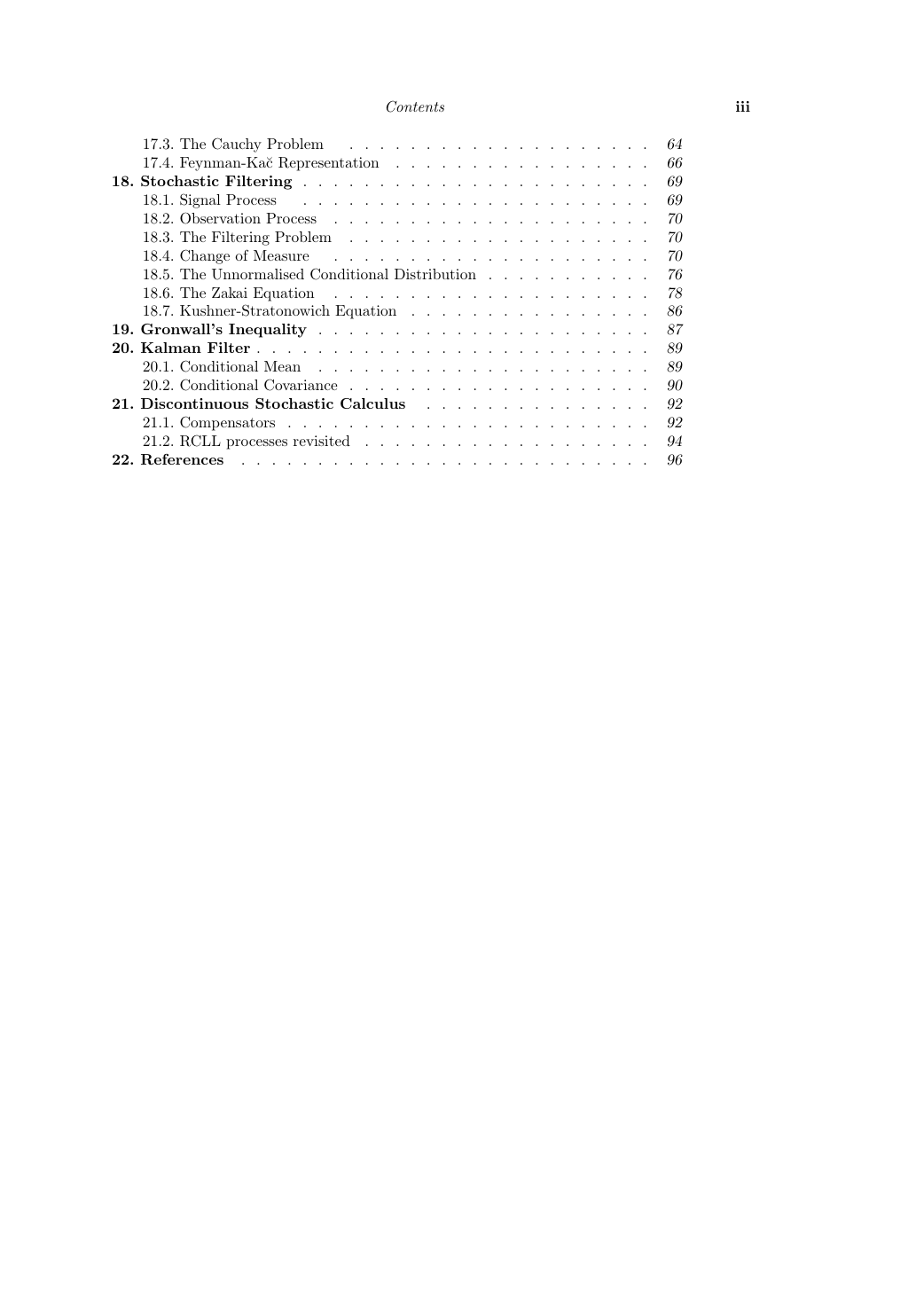
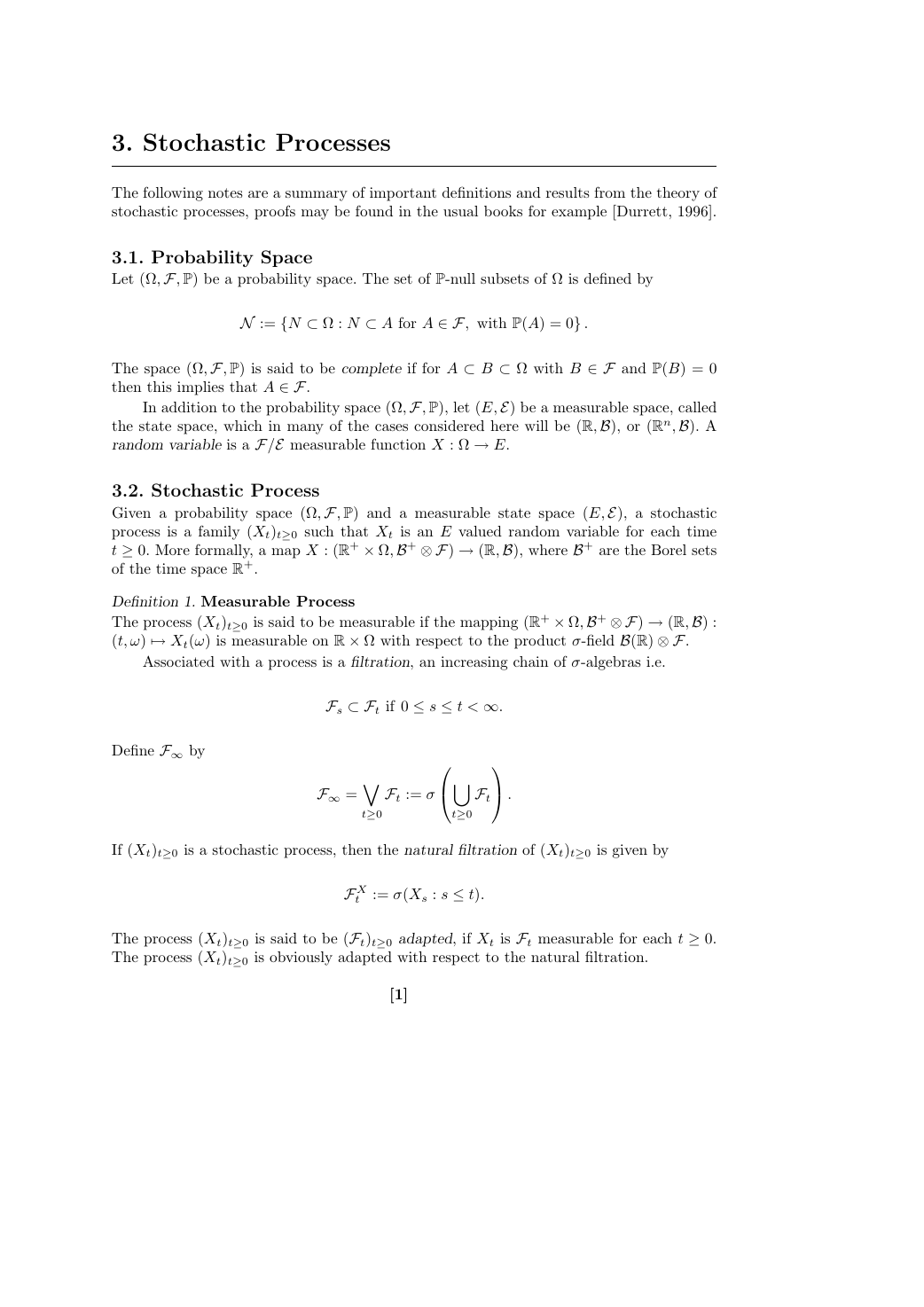
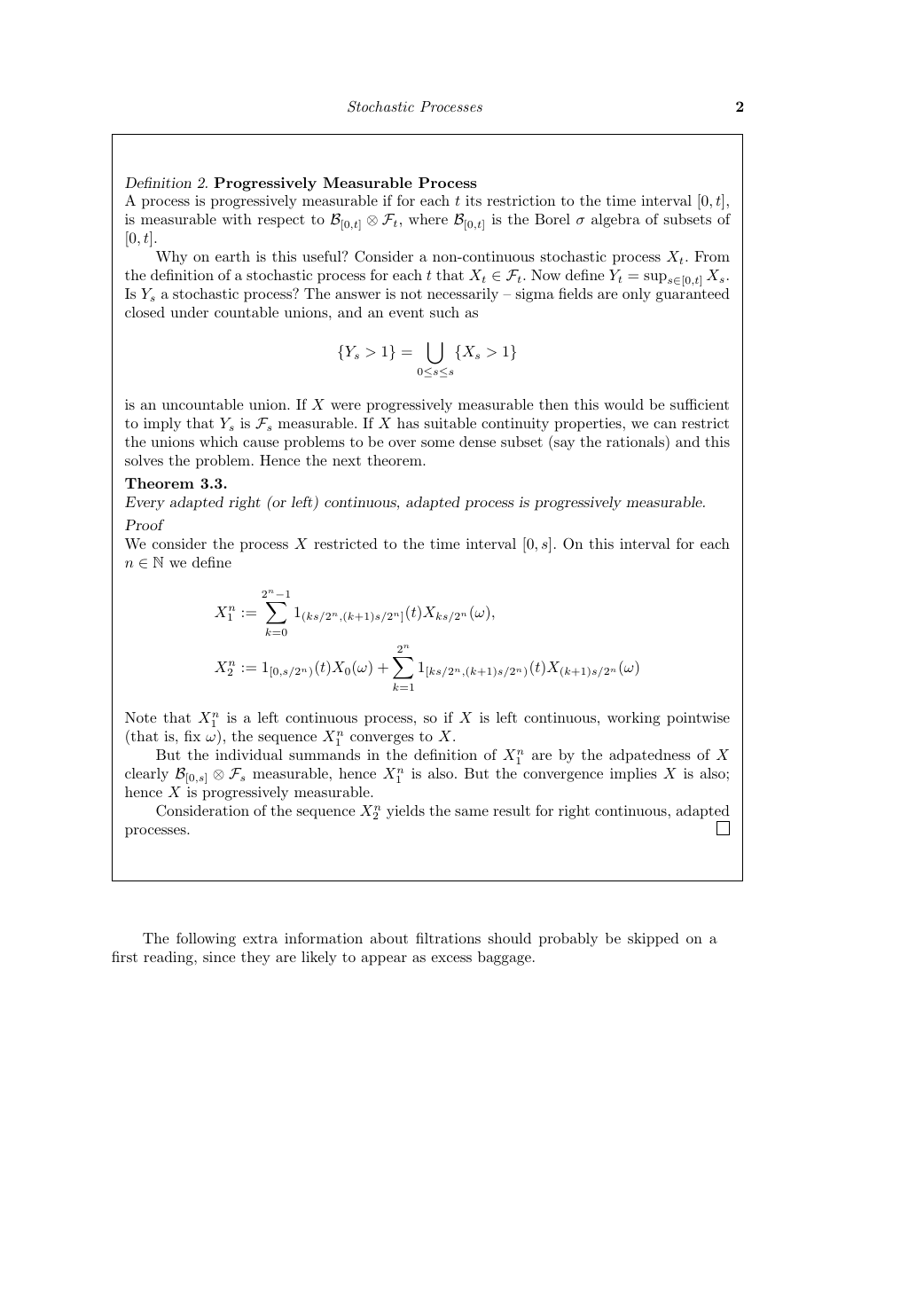

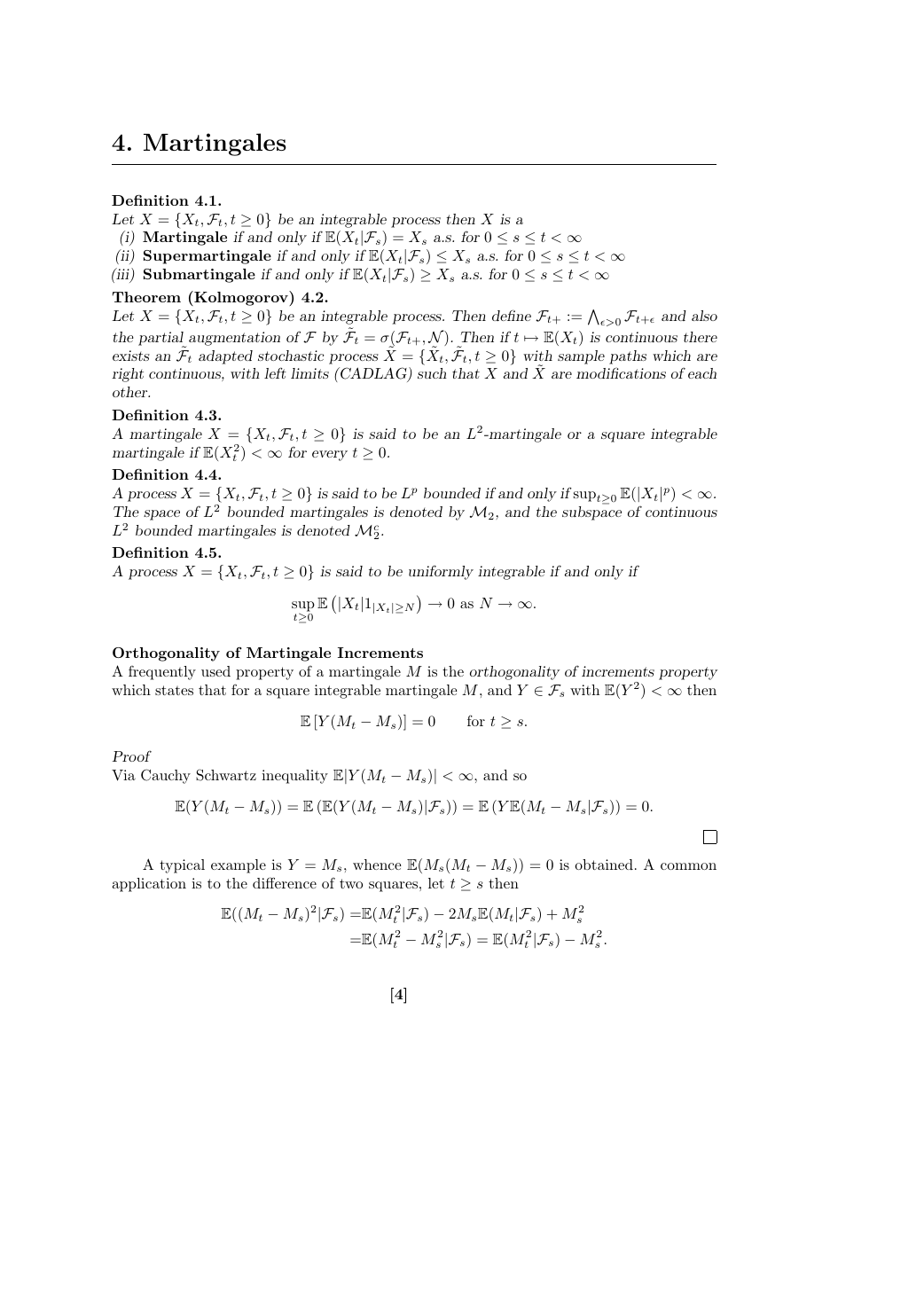








 2023年江西萍乡中考道德与法治真题及答案.doc
2023年江西萍乡中考道德与法治真题及答案.doc 2012年重庆南川中考生物真题及答案.doc
2012年重庆南川中考生物真题及答案.doc 2013年江西师范大学地理学综合及文艺理论基础考研真题.doc
2013年江西师范大学地理学综合及文艺理论基础考研真题.doc 2020年四川甘孜小升初语文真题及答案I卷.doc
2020年四川甘孜小升初语文真题及答案I卷.doc 2020年注册岩土工程师专业基础考试真题及答案.doc
2020年注册岩土工程师专业基础考试真题及答案.doc 2023-2024学年福建省厦门市九年级上学期数学月考试题及答案.doc
2023-2024学年福建省厦门市九年级上学期数学月考试题及答案.doc 2021-2022学年辽宁省沈阳市大东区九年级上学期语文期末试题及答案.doc
2021-2022学年辽宁省沈阳市大东区九年级上学期语文期末试题及答案.doc 2022-2023学年北京东城区初三第一学期物理期末试卷及答案.doc
2022-2023学年北京东城区初三第一学期物理期末试卷及答案.doc 2018上半年江西教师资格初中地理学科知识与教学能力真题及答案.doc
2018上半年江西教师资格初中地理学科知识与教学能力真题及答案.doc 2012年河北国家公务员申论考试真题及答案-省级.doc
2012年河北国家公务员申论考试真题及答案-省级.doc 2020-2021学年江苏省扬州市江都区邵樊片九年级上学期数学第一次质量检测试题及答案.doc
2020-2021学年江苏省扬州市江都区邵樊片九年级上学期数学第一次质量检测试题及答案.doc 2022下半年黑龙江教师资格证中学综合素质真题及答案.doc
2022下半年黑龙江教师资格证中学综合素质真题及答案.doc